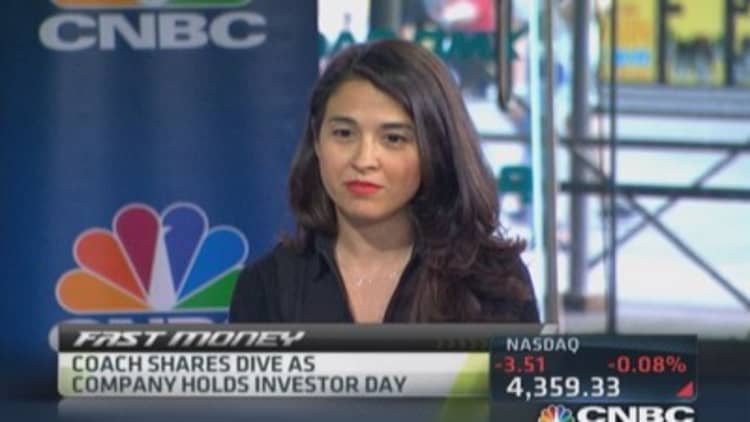Kwak Ji-yoon, a 42-year-old South Korean housewife, used to be a loyal customer of Louis Vuitton but she does not buy LV bags any more. Instead, she recently bought a $1,000 white metal-studded handbag made by Alexander Wang.
"I already have five Louis Vuitton bags. When you take a subway, you see three or four Louis Vuitton bags in just one carriage. People no longer say 'wow' when you carry an LV bag," she says. "But my friends ask where I bought my new handbag because the design is not common. And it is much more affordable than traditional luxury bags."
Ms Kwak is not alone. The €8.3 billion South Korean luxury market, Asia's third largest behind China and Japan, has become a tougher place for global fashion houses to compete as young consumers turn to more accessible "contemporary brands" amid waning popularity of expensive premium brands such as Gucci, Louis Vuitton, Ferragamo and Burberry, and with domestic consumption mired in a prolonged slump.
Read MoreTough times for luxury retail in China
"The luxury market here is going through an important shift," says Song Ji-hye, a partner at Bain & Company. "Some of the famous luxury brands are struggling to keep up with trends, with demand for them replaced by more accessible contemporary brands, while ultra high-end brands such as Chanel and Hermès still enjoy strong sales."
Louis Vuitton was once the most popular luxury brand in South Korea, and its handbags garnered the nickname of "three-second bags" because of their ubiquitous appearances.
But the market has become more challenging in recent years, with increasingly sophisticated shoppers looking for new brands with distinctive designs that help them stand out from the crowd.
Read MoreMulberry turnaroundfalters as luxury brands diverge
Fashion-savvy young Koreans have also become more price-sensitive as sales channels such as online shopping and outlets allow them to seek bargains rather than pay full price.
"We often see younger luxury buyers, who have become the market's main growth drivers, looking for trendier brands such as Givenchy or Celine rather than classic designs of Chanel or Louis Vuitton," says Bang Jae-won, the chief merchandiser at Lotte Department Store. "They like to mix and match outfits such as wearing H&M clothes but carrying a Hermès bag. And most of them prefer value consumption through online shopping or outlets."

South Korea is still a growing market for most luxury makers, but some of the traditional premium brands, which used to rule the market, are now suffering from slowing sales growth and weakening profitability, compared with double-digit growth during a few boom years leading up to 2012.
Shinsegae Department Store saw its sales growth of luxury goods fall from 32 per cent in 2011 to just 4 per cent last year, while Lotte's luxury sales growth fell from 21.3 per cent to 7.8 per cent over the same period. Brands such as Bally have pulled out of the country, while Ferragamo recently closed its shop at the newly renovated Galleria department store.
Read MoreCoach is takingafter JC Penney: Analyst
Fashion houses including Ferragamo, Dior and Coach have replaced their country heads in Korea to adapt to changing trends, while some brands have brought forward their off-season sales in department stores.
Burberry's South Korea sales contracted 5.2 per cent in the 12 months to March 2013, with its operating profit down falling 40 per cent to ₩21 billion ($21m).
Both Christian Dior and Longchamp suffered operating losses in Korea last year, while Mulberry issued a series of profit warnings – partly because of weak wholesale sales in Korea – as the UK brand lost its luster in spite of efforts to go upmarket.
More from the Financial Times:
From 'Game of Thrones' to Iraq for FireChat
Manufacturing data lift Asia bourses
Labourplans full review of Universal Credit
"The days when luxury products sold well with just logo play are gone as the market becomes more mature with refined consumer tastes," says Gemma Yun, a merchandiser at the Galleria department store. "Now, luxury makers have to rack their brains to keep their image fresh without undermining authenticity. Otherwise, they cannot stay relevant in this market."
In spite of slowing growth, South Korea is still an important market for luxury brands, thanks to the growing popularity of Korean TV dramas and music, industry analysts say.
The brands need a strong foothold in Seoul to identify trends that can spread from here, they add. Luxury sales at the country's duty-free shops remain strong thanks to the increasing number of Asian visitors, especially Chinese travelers, who spend big on overseas tours.
Read MoreHow to get rich men to go mansion shopping
Luxury groups including Chanel, Gucci and Louis Vuitton have used product placements in Korean TV dramas to broaden their appeal to young consumers, with Celine dresses and Jimmy Choo shoes seeing sales spikes after being worn by South Korean actress Jun Ji-hyun in the popular soap-opera "My Love from the Star" .
"The Korean market has strategic value to global luxury brands in that it is widely viewed as the fashion leader in the region," says Aimee Kim, a partner at McKinsey. "Luxury brands need to be more effective in marketing to Chinese travelers. They are capable and willing to indulge when visiting Korea."




